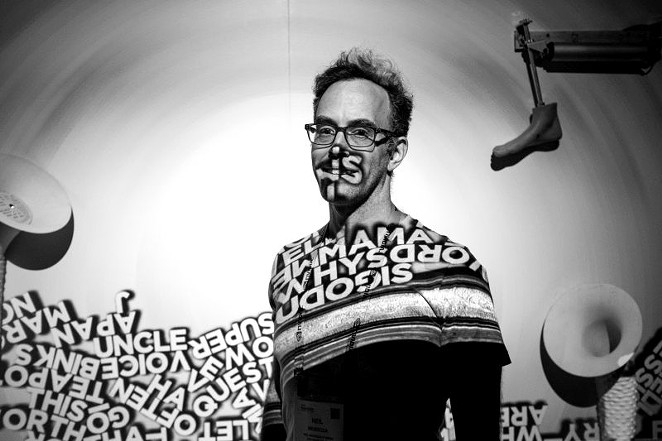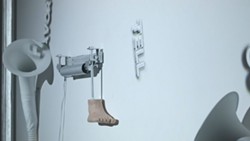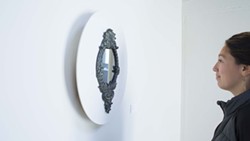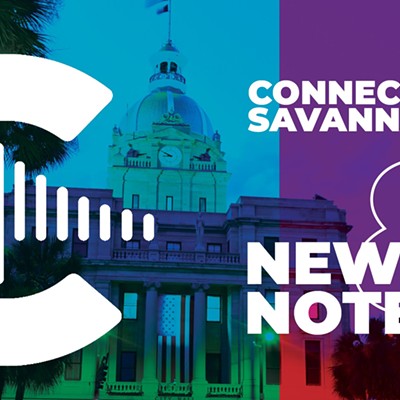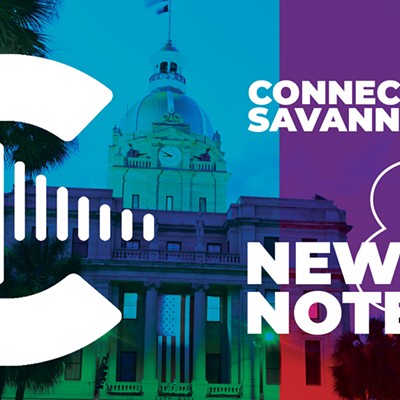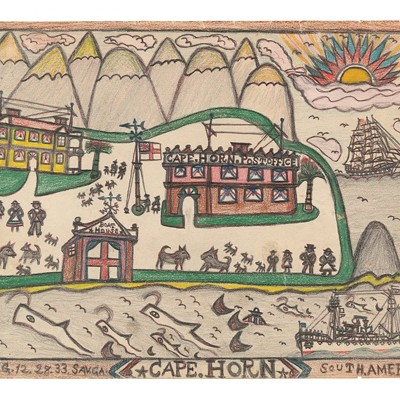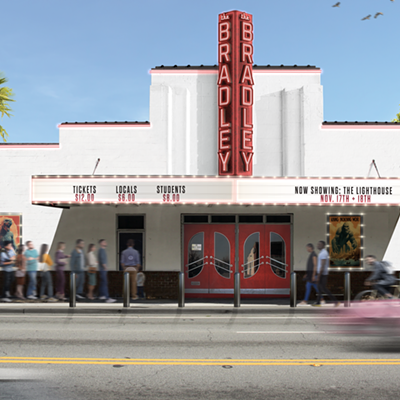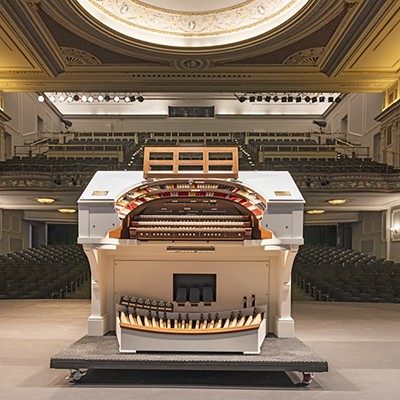TECHNOLOGY has become so integrated into our daily lives that it’s hard to imagine where we’d be without it. But do we actually need the tech improvements that fill our days?
When we use technology designed to make our lives easier, like facial recognition software or voice-to-text technology, that ease comes at a cost: we’re freely giving our information, and by proxy our freedom, to corporations that manipulate our dependence on technology for capitalistic gain.
Neil Mendoza’s “Robotic Activated Word Kicking Machine” shows the process of that technology: speak into the machine and your words appear on screen. But only some of the words appear, highlighting the
He is also the creator of the “Anti-Vanity Mirror,” a mirror that runs away from the viewer looking into it.
Mendoza’s work fits perfectly with this year’s PULSE exhibition, “Machines of Futility: Unproductive Technologies.” Opening on Thursday, the exhibition features two of Mendoza’s works, both of which comment on technology today.
We spoke with Mendoza last week.
Have you always been interested in making art that questions the futility of technology?
I think so. I think it’s much easier to analyze the work you’re into once you’ve been making work for a while. I think I was just kind of doing what I felt like making. After I’d been making work for a while, it became a theme that came out in a lot of my pieces, like this absurdity and using technology in slightly unexpected ways.
For a few years I wasn’t making art; I was doing other jobs like a web developer, finance, that kind of stuff. But I always knew that I wanted to be doing something creative. One of the web development companies I was at was making generative art, so that started me on that. I started playing around with processing, which is a tool for making generative art and experimenting. That was right at the beginning when I started making art out of technology.
So I’ve just been experimenting and it took a while for this direction to come out of exploring the slightly surreal side of technology. I was making some work on my own, and then in 2014 I came to the US to do an MFA at UCLA and stuck around ever since. Before I came to the US, I was doing art and freelance work, and since then I’ve been mainly focusing on my art career, which I guess is more the time period where I started to refine the direction of my work.
How did you go about refining the direction?
I think a lot of my projects have this ... A lot of the way we are using technology today is marketed to us by companies. It’s based on selling you more time on social networks or selling you on more devices, rather than improving your experience. I think I like to use technology in ways that are completely the opposite direction, trying to break people’s preconceptions about what technology can be rather than this time-sapping device. It can be anything, which I hope it inspires people to think about.
The first piece you have on display is the “Robotic Voice Activated Word Kicking Machine,” which questions the usefulness of voice-to-text technology. Can you speak more on that?
You speak to these robots, like when you phone the bank and they keep you on hold for 20 minutes talking to a robot. But also, if you speak to Alexa or Google Home, it’s sending all this data to the cloud. In your head you’re just talking to a friend, but in reality there’s a huge corporate entity collecting all this data about you every time you speak to one of these devices. That piece was trying to make that interaction a bit more tangible. When people interact with that piece, they see their words appear on the screen and they’re like, “That’s amazing.” But that’s exactly what’s happening in whichever one of these company’s databases. When you’re like, “Hey Siri, do this or that,” all your words are being turned into text and being stored in a database somewhere.
What have the reactions to the piece been like?
Beyond the slightly darker side of surveillance, I think people really just enjoy playing with it. A lot of technology is quite solo, so often you’re using the Internet on your own, using the phone on your own, and the nice thing about [the machine] is that you get these group dynamics where different people will come up and use it in different ways. Some people will be like, “How can I break it with the longest word possible? Can I swear at it?” There’s a lot of supercalifragilisticexpialodocious. But it’s fun seeing the group dynamics that form when people interact with it in different ways, throwing it different content.
The second piece is the “Anti-Vanity Mirror,” which is a commentary on selfie culture. How did that piece come about?
Originally, I created it when I was doing a residency at the rubbish dump in San Francisco. The trash company Recology has a residency where they let artists spend two to three months in a studio onsite, and you can go to the place where people drop their own trash off, like furniture and computers, and you reclaim it and turn it into art. The Anti-Vanity Mirror was actually completely made from recycled materials, but this version in Savannah I’ve actually upgraded some of it with stuff which didn’t come from the trash.
It can slide left and right along the wall. The wall is a two-way mirror, so there’s a camera behind the mirror, and when it sees someone look at it, it runs away until it gets them out of its view. It basically doesn’t like people looking at it.
There’s a strong sense of humor in your work. Is that intentional?
It seems to be a thing which keeps coming back into my work; it does seem to keep being a component of my art. I think when you’re talking about these kinds of issues, if you’re very didactic and serious about it, people already know those issues are issues and they don’t need more preaching about it. But if you take a slightly lighter approach to commentary on these issues, I think maybe it sticks with people longer. You’re not educating people because everyone’s kind of aware of it already. But I guess that’s another thing. If you make these whimsical machines, it suggests a future in which technology can be anything. It doesn’t just have to be privacy-invading devices.
Do you think we’ll see technology take that turn?
I hope that by creating the work I do, I inspire people to realize they can go out there and create their own technology. I think technology made by big corporate entities will always have this incentive to make it privacy-invading and money-sucking, so it’s only really going to change if it’s more of a grassroots movement, and that’s possible nowadays because of all the accessible maker technologies. Like, it’s so cheap to 3D print something, and there are so many programming toolkits that make it easy to write software. So I think it’s going to be very hard to stop the momentum of consumer technology going in this direction, but the fact that it’s much easier for consumers to start creating their own technology suggests the possibility of a slightly less dystopian future.
This reminds me of the book “A Whole New Mind” by Daniel H. Pink, which suggests that creativity will ultimately be most important in technology.
I think also just because the way society functions is changing so fast, creativity is a much more useful skill to teach than rote learning, because it’s changing at such a pace that if you don’t know how to be creative and learn to learn, then you’re going to get left behind.
What other projects are you currently working on?
I’m doing a residency at the Children’s Museum of Pittsburgh, Museum Lab, which is a new museum they just started. I’m making a flock of robotic birds out of bread, because I’m trying to rescue bread from the tyranny of real birds. So you’re going to have video monitors with real birds on it, and when the real birds move around, they’re going to trigger the flock of bread birds to fly away from them. I’m leaving a video camera inside this bird feeder so I can get bird footage, and I’m doing lots of baking experiments to learn how to bake birds in the shape of bread and work out how the robot part is going to work. There’s a lot of different parts to this project; I’ll be done the end of February.

